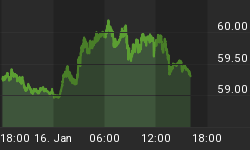The following is part of Pivotal Events that was published for our subscribers September 29, 2015.
Signs of The Times
"Homes listed for $100 million or more are piling up fast, but sales have ground to a halt."
- CNBC, September 16.
"Home Builder Confidence in U.S. Strengthens to Highest Since 2005"
- Bloomberg, September 16.
"Copper has the best supply fundamentals among base metals."
- Diapason Commodities, September 21.
"Governments in some of the poorest countries are revisiting plans to sell billions of dollars of bonds."
- Financial Times, September 24.
"Refugees Shop for Best Handouts and Climate; 'Finland's No Good'"
- Mish, September 27.
Stock Markets
Our near-term target has been the low closes on August 24th, which levels are being reached. This would follow the momentum CCI bouncing to 100 (![]() ).
).
Our longer-term view on July 23rd was that the bull market was over. Our "Friends of the bull market" had been useful and had reached their "Best Before" date.
If the intra-day extremes are taken out it would mark the start of a cyclical bear market. Global stock markets (VEU) are virtually at the extreme. So are Biotechs (IBB). STOXX is almost there. The NYSE Comp (NYA) is at the low close. SSEC, having suffered the brunt of the storm, is a couple of percentage points above the low close.
Is this oversold enough to look for a bottom for this slide?
The senior indexes could spend a brief period at their August 24th closes. But it is possible that this could go to extremely oversold.
The S&P Weekly RSI is down to 31. Seasonal extreme RSIs in 2008 and in 2002 were at the 26 level.
Also, the typical seasonal low for the full discovery of illiquid markets has been in October. Small Caps (RUT) led the market turn in setting its high in June. The Weekly RSI is down to 31, around 26 would be extreme.
Momentum for Banks (XBD) is down to 36. Extreme would be just under 30.
Seasonality got us this far. Seasonality could bottom some two to four weeks from now. Momentum has further to go.
The prospect of trying to catch falling knives is always ghastly. Particularly as it overwhelms "buying the dips". Ross will be monitoring for Downside Capitulations on momentum and Sequential Buys for pattern.
Credit Markets
Financial markets are again suffering declining liquidity and the intellectual classes are discussing whether the Fed should increase administered rates. Can't believe it, but at least there is none of the nonsense last seen in late 2007. The Fed would cut rates and all would be well.
On this transition from bull market to contraction, credit spreads provided the guide - again. It worked for us in 2008, 2007 and with the LTCM disaster in 1998.
Spreads were expected to reverse to widening in May-June and complete the critical breakouts in July. This time around, the key breakout occurred in early August.
The initial hit took the spread (BBB to Treasuries) to 229 bps on August 26th. That week's Pivot considered that relief could run for two to four weeks, when widening would resume. The best on relief was 220 bps set on September 24th. Monday's number was 235 bps and widening has resumed.
We can track the technical dynamics on the ETFs. The "relief" made it to the 200-Day ma on September 17th. At .288 now it compares to .283 on Black Monday. Importantly, the Weekly RSI is at 38. Serious oversolds occurred at the 26 level last January and in October 2011.
The hit in JNK has further to run in price, season and momentum.
The following chart reviews the action in Junk in 2008 when the yield soared from 7.50 percent to over 23 percent. The increase was more than 15 percentage points.
The last cyclical low yield was set at 5.16% in June 2014. Fifteen percentage points puts the target at 20 percent. It is now at 7.98%.
Over in Treasuryland, TLT has rallied with this week's decline in equities. The low was 118.55 a couple of weeks ago. Monday's rally amounted to 2 points to 123.77. This is at the 200-Day ma. If it breaks out the next level of resistance is at 125.
While TLT can rally with these setbacks, we think the game has been played too many times.
A classic post-bubble contraction drives real rates (net of CPI inflation) up. In senior currency terms the increase has been in the order of 12 percentage points. It seems that a huge increase in the real cost of interest was needed to end the abuse of credit, otherwise known as a new financial era.
Currencies
For the past two weeks the DX has been trading between the 50-Day (above) and the 200-Day (support). Since early August, stock market declines have occurred with a weakening dollar. The low was 92.52 on Black Monday.
It is at 96.20 and we will let the chart tell us about the next near-term move. On the longer-term, we have been expecting debt service flows into New York to eventually drive the dollar up. That would be relative to most other currencies. In a financial world corrupted by intuitively contrived economic theories, a firming dollar, as the saying goes, would be equivalent to the guy in the leper colony with the most fingers. The Canadian dollar has been expected to be steady following Black Monday.
Other than the sudden jump to 76.82, most of the trade was at the 75.50 level. However, over the last three days it has dropped to 74.54.
The last rally was to 82.47 in June, which was just above the 50-Day ma. The next prominent rally was the one to 76.82, which was about the same amount above the same moving average.
The downtrend has resumed.
Link to October 1, 2015 Bob Hoye interview on TalkDigitalNetwork.com: http://talkdigitalnetwork.com/2015/10/credit-spreads-becoming-dramatic/ Listen to the Bob Hoye Podcast every Friday afternoon at TalkDigitalNetwork.com
















